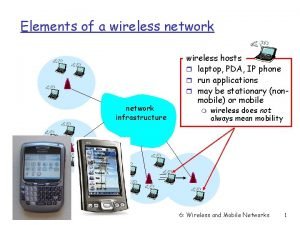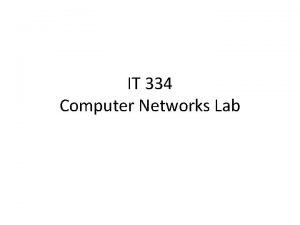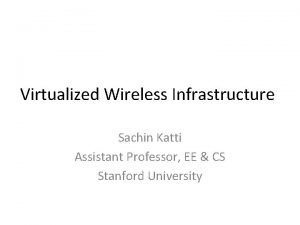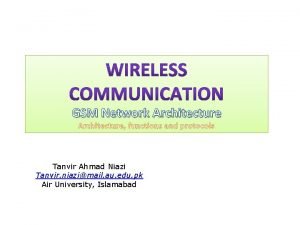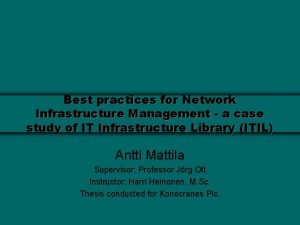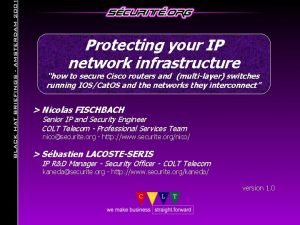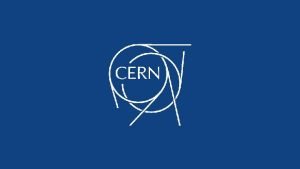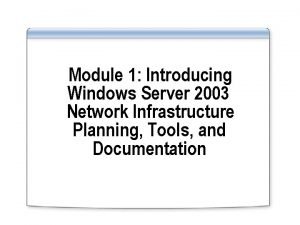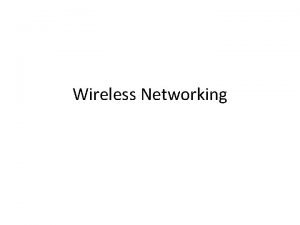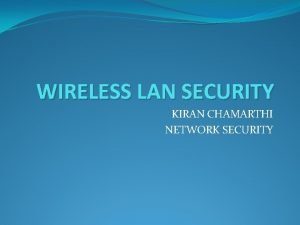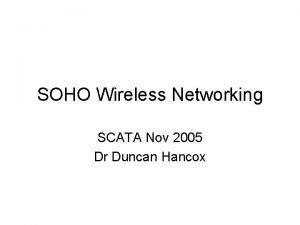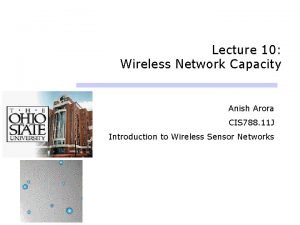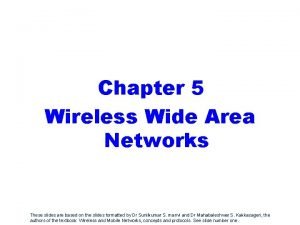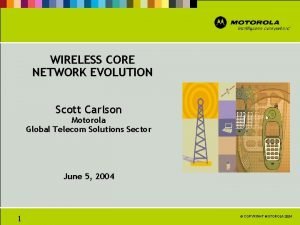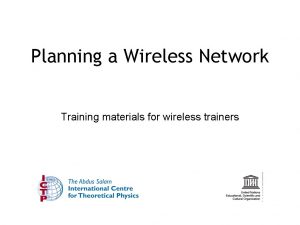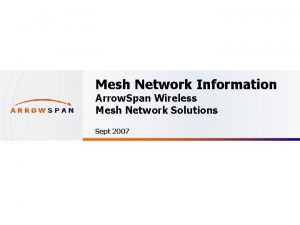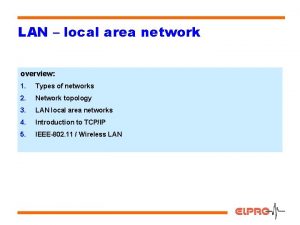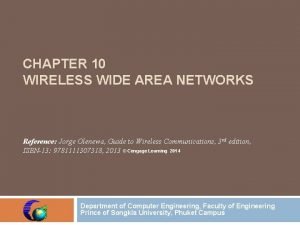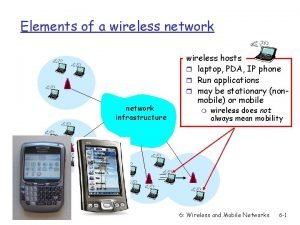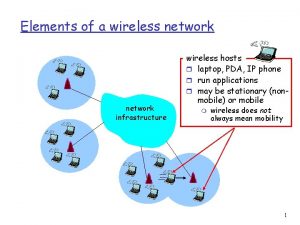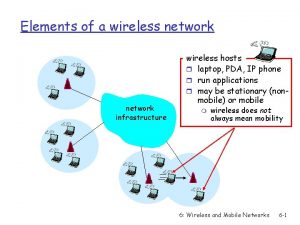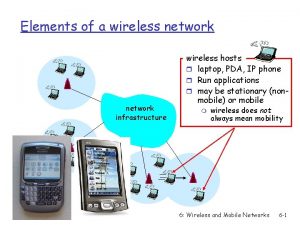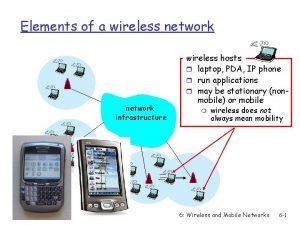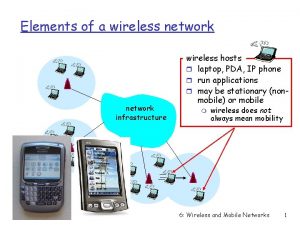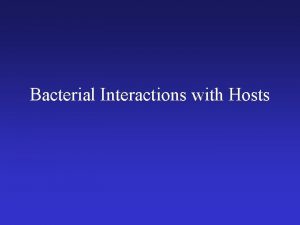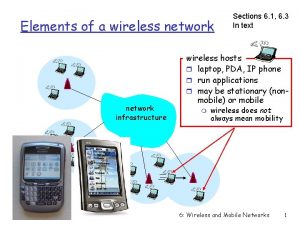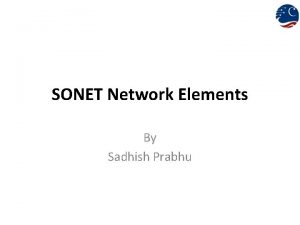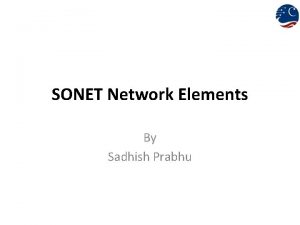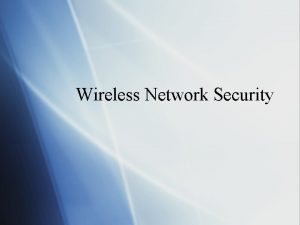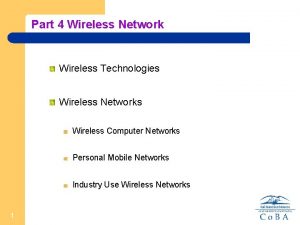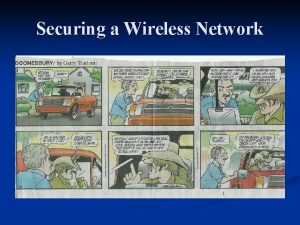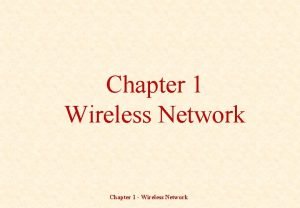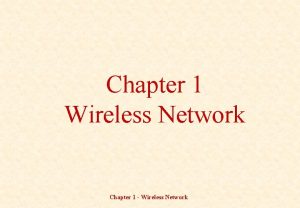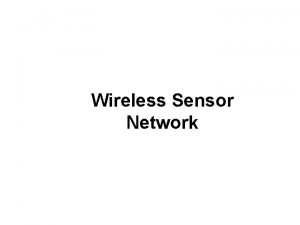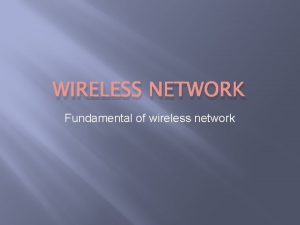Elements of a wireless network infrastructure wireless hosts




























- Slides: 28

Elements of a wireless network infrastructure wireless hosts r laptop, PDA, IP phone r run applications r may be stationary (nonmobile) or mobile m wireless does not always mean mobility 6: Wireless and Mobile Networks 1

Elements of a wireless network infrastructure base station r typically connected to wired network r relay - responsible for sending packets between wired network and wireless host(s) in its “area” m cell towers m 802. 11 access points 6: Wireless and Mobile Networks 2

Elements of a wireless network infrastructure wireless link r typically used to connect mobile(s) to base station r also used as backbone link r multiple access protocol coordinates link access r various data rates, transmission distance 6: Wireless and Mobile Networks 3

Characteristics of selected wireless link standards mesh 54 Mbps 5 -11 Mbps 802. 11{a, g} 802. 16 e. 11 or p-to-p Mobile link. Wi. MAX 802. 11 b 802. 15 3 G UMTS/WCDMA, CDMA 2000 384 Kbps 2 G IS-95 CDMA, GSM 56 Kbps Indoor Outdoor Mid range outdoor Long range outdoor 10 – 30 m 50 – 200 m – 4 Km 5 Km – 20 Km 6: Wireless and Mobile Networks 4

Wi. Max Vs. Wireless Mesh r Wi. Max m Similar to cellular network infrastructure m Use licensed spectrum m 10 Mbit/s at 10 km in good environment m Is under development by many companies r Wireless Mesh m Extension of 802. 11 Wireless LAN m Use unlicensed public spectrum m 802. 11’s access routers interconnect together • Ad Hoc (usually non-mobile) networking and routing m Currently used in some places • Town & small city’s government agents (firefighter, police) – More popular in Europe than in US • Challenges: complex routing, high error rate, Qo. S 6: Wireless and Mobile Networks 5

Elements of a wireless network infrastructure mode r base station connects mobiles into wired network r handoff: mobile changes base station providing connection into wired network 6: Wireless and Mobile Networks 6

Elements of a wireless network Ad hoc mode r no base stations r nodes can only transmit to other nodes within link coverage r nodes organize themselves into a network: route among themselves Wireless active research area: Ad hoc network Sensor network 6: Wireless and Mobile Networks 7

Ad Hoc Vs. Sensor Networks r Ad Hoc network m Challenge Mobility of nodes m Good features: Plenty of power, computation resource m Applications • Mostly mobile laptops or PDAs • Vehicular network r Sensor network m Challenge limited power, computing resource m Good features: • Usually stationary, dense network m Applications • Military battlefield, civil engineering, environmental monitoring 6: Wireless and Mobile Networks 8

Wireless Link Characteristics Differences from wired link …. m m m decreased signal strength: radio signal attenuates as it propagates through matter (path loss) interference from other sources: standardized wireless network frequencies (e. g. , 2. 4 GHz) shared by other devices (e. g. , phone); devices (motors) interfere as well multipath propagation: radio signal reflects off objects ground, arriving at destination at slightly different times …. make communication across (even a point to point) wireless link much more “difficult” 6: Wireless and Mobile Networks 9

IEEE 802. 11 Wireless LAN r 802. 11 b m 2. 4 -2. 485 GHz unlicensed radio spectrum m up to 11 Mbps m direct sequence spread spectrum (DSSS) in physical layer • all hosts use same chipping code m widely deployed, using base stations r 802. 11 a m 5. 1 -5. 8 GHz range m up to 54 Mbps r 802. 11 g m 2. 4 -2. 485 GHz range m up to 54 Mbps m Use OFDM in physical layer r All use CSMA/CA for multiple access r All have base-station and ad-hoc network versions 6: Wireless and Mobile Networks 10

802. 11 LAN architecture r wireless host communicates Internet AP hub, switch or router BSS 1 AP BSS 2 with base station m base station = access point (AP) r Basic Service Set (BSS) (aka “cell”) in infrastructure mode contains: m wireless hosts m access point (AP): base station m ad hoc mode: hosts only 6: Wireless and Mobile Networks 11

802. 11: Channels, association r 802. 11 b: 2. 4 GHz-2. 485 GHz spectrum divided into 11 channels at different frequencies m m m 11 channels are partial overlapping (1, 6, 11 non-overlapping) AP admin chooses frequency for AP interference possible: channel can be same as that chosen by neighboring AP! r host: must associate with an AP m scans channels, listening for beacon frames containing AP’s name (SSID) and MAC address m selects AP to associate with m may perform authentication [Chapter 8] m will typically run DHCP to get IP address in AP’s subnet 6: Wireless and Mobile Networks 12

IEEE 802. 11: multiple access r 802. 11: CSMA - sense before transmitting m don’t collide with ongoing transmission by other node r 802. 11: no collision detection! m difficult to receive (sense collisions) when transmitting due to weak received signals (fading) m can’t sense all collisions in any case: hidden terminal, fading m goal: avoid collisions: CSMA/C(ollision)A(voidance) C A B C C’s signal strength A’s signal strength space 6: Wireless and Mobile Networks 13

IEEE 802. 11 MAC Protocol: CSMA/CA 802. 11 sender 1 if sense channel idle for DIFS then transmit entire frame (no CD) 2 if sense channel busy then start random backoff timer counts down while channel idle transmit when timer expires if (no ACK) sender receiver DIFS increase random backoff interval, repeat 2 data else /* received ack */ return back to 2 (why? ) to transmit next frame 802. 11 receiver - if frame received OK SIFS ACK return ACK after SIFS (ACK needed due to hidden terminal problem) (no ack in ethernet!!) DIFS: distributed inter-frame spacing, SIFS: short inter-frame spacing 6: Wireless and Mobile Networks 14

Avoiding collisions (more) idea: allow sender to “reserve” channel rather than random access of data frames: avoid collisions of long data frames r sender first transmits small request-to-send (RTS) packets to BS using CSMA m RTSs may still collide with each other (but they’re short) r BS broadcasts clear-to-send CTS in response to RTS r RTS heard by all nodes m sender transmits data frame m other stations defer transmissions Avoid long data frame collisions using small reservation packets! 6: Wireless and Mobile Networks 15

Collision Avoidance: RTS-CTS exchange A B AP DIFS RTS(B) RTS(A) reservation collision RTS(A) CIFS CTS(A) DATA (A) time defer CIFS ACK(A) 6: Wireless and Mobile Networks 16

RTS/CTS in Practice r RTS/CTS introduces delay, consume channel resource. m Benefit when the data frame is much larger than RTS/CTS. r APs set threshold of data frame length in order to use RTS/CTS m If > threshold, use RTS/CTS r Many APs skip RTS/CTS by using a threshold larger than the Max frame length 6: Wireless and Mobile Networks 17

802. 11 frame: addressing 2 2 6 6 6 frame address duration control 1 2 3 Address 1: MAC address of wireless host or AP to receive this frame 2 6 seq address 4 control 0 - 2312 4 payload CRC Address 4: used only in ad hoc mode Address 3: MAC address of router interface to which AP is attached Address 2: MAC address of wireless host or AP transmitting this frame 6: Wireless and Mobile Networks 18

802. 11 frame: addressing R 1 router H 1 Internet AP R 1 MAC addr AP MAC addr dest. address source address 802. 3 frame AP MAC addr H 1 MAC addr R 1 MAC address 1 address 2 address 3 802. 11 frame 6: Wireless and Mobile Networks 19

802. 11 frame: more duration of reserved transmission time (data, RTS/CTS) 2 2 6 6 6 frame address duration control 1 2 3 2 Protocol version 2 4 1 Type Subtype To AP 6 2 1 seq address 4 control 1 From More AP frag 1 Retry 1 0 - 2312 4 payload CRC 1 Power More mgt data 1 1 WEP Rsvd frame type (RTS, CTS, ACK, data) 6: Wireless and Mobile Networks 20

802. 11: mobility within same subnet r H 1 remains in same IP subnet: IP address can remain same r switch: which AP is associated with H 1? m self-learning (Ch. 5): switch will see frame from H 1 and “remember” which switch port can be used to reach H 1 m AP 2 broadcast H 1’s MAC to switch router hub or switch BBS 1 AP 2 H 1 BBS 2 6: Wireless and Mobile Networks 21

802. 15 MAC and Bluetooth r 802. 11 MAC m 11 Mbps – 54 Mbps m Up to 100 meters range r 802. 15 MAC m Wireless personal area network (WPAN) m < 10 meters range m Simple (cheap) device, low power assumption m Cable, wire replacement • E. g. , mouse, keyboard, headphone m Example: Bluetooth 6: Wireless and Mobile Networks 22

Bluetooth r Physical layer properties: m 2. 4 GHz unlicensed spectrum m Frequency-hopping spread spectrum • 79 channels with different frequencies • TDM transmit: jump among channels with preset sequences (coding) m Up to 721 bps (802. 11 is 11 Mbps to 54 Mbps) 6: Wireless and Mobile Networks 23

Bluetooth r Ad hoc network structure r One master, <=7 slaves m m Odd time slot: master Even time: slaves r Parked: inactive devices r Problem: slow speed can be achieved by RF device m Much cheaper, simpler 6: Wireless and Mobile Networks 24

CDMA Principle (6. 2. 1) r Code Division Multiple Access m Wide spectrum technique m All users use the full spectrum m Users with different codings not interfere r Each bit is encoded by much high rate signal (code) m Receiver can recover the bit with the corresponding code 6: Wireless and Mobile Networks 25

CDMA example 6: Wireless and Mobile Networks 26

Working with multiple users r How to extract data when multiple users transmit at the same time? r Assumptions: m Interfering signals are additive m Signal 1+1+1+(-1) = 2 r New signals in the air (N senders): Same decoding formula! 6: Wireless and Mobile Networks 27

Why extract correctly By each user? A: user codes are orthogonal 6: Wireless and Mobile Networks 28
 Elements of a wireless network
Elements of a wireless network Autodesk hosts file
Autodesk hosts file Ncic restricted files
Ncic restricted files Cjis meaning
Cjis meaning Networking lab exercises
Networking lab exercises Sachin katti
Sachin katti What are wireless devices and the wireless revolution
What are wireless devices and the wireless revolution Gsm network structure
Gsm network structure Advanced network infrastructure
Advanced network infrastructure Infrastructureless
Infrastructureless Network infrastructure management
Network infrastructure management Ip network infrastructure
Ip network infrastructure Generic framework of electronic commerce
Generic framework of electronic commerce Berkeley open infrastructure for network computing
Berkeley open infrastructure for network computing School planning team organizational structure
School planning team organizational structure Wireless network definition
Wireless network definition Wireless network security definition
Wireless network security definition Soho network definition
Soho network definition Wireless security in cryptography
Wireless security in cryptography Receiver sensitivity
Receiver sensitivity Wireless sensor network protocols
Wireless sensor network protocols Wireless wide area network
Wireless wide area network Dilbert wireless network
Dilbert wireless network Earth.google.c
Earth.google.c Outdoor wireless mesh network design
Outdoor wireless mesh network design A type of wireless local area network technology
A type of wireless local area network technology Telosb
Telosb Wireless wide area network
Wireless wide area network Skymanage
Skymanage
